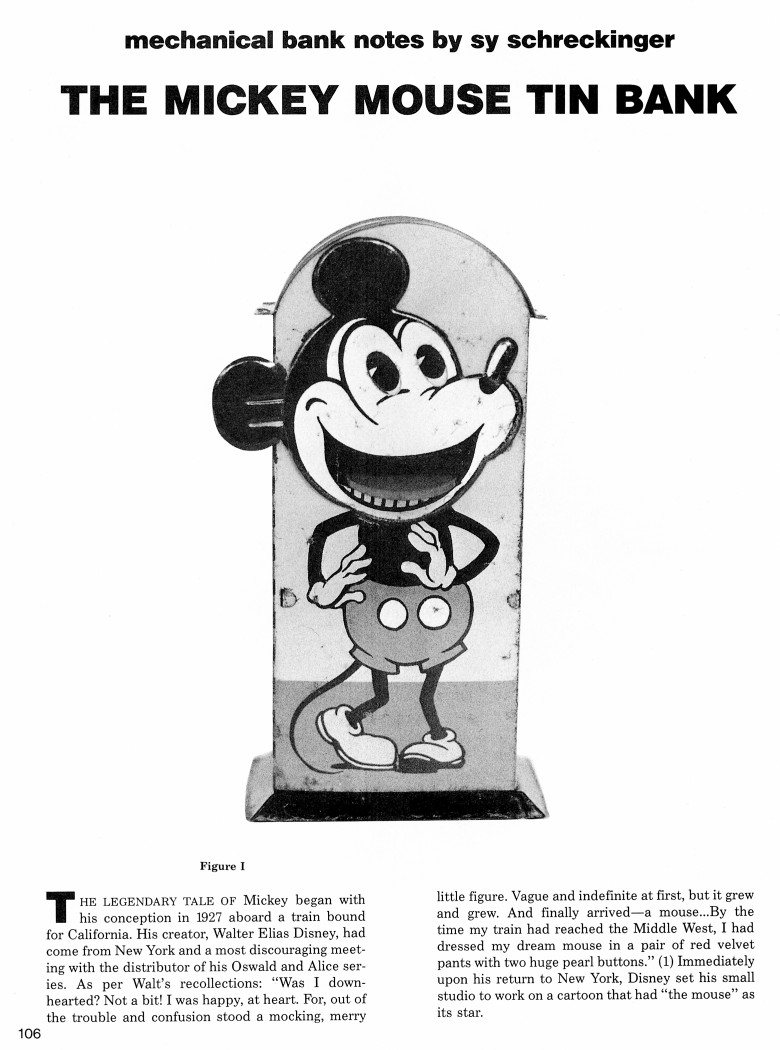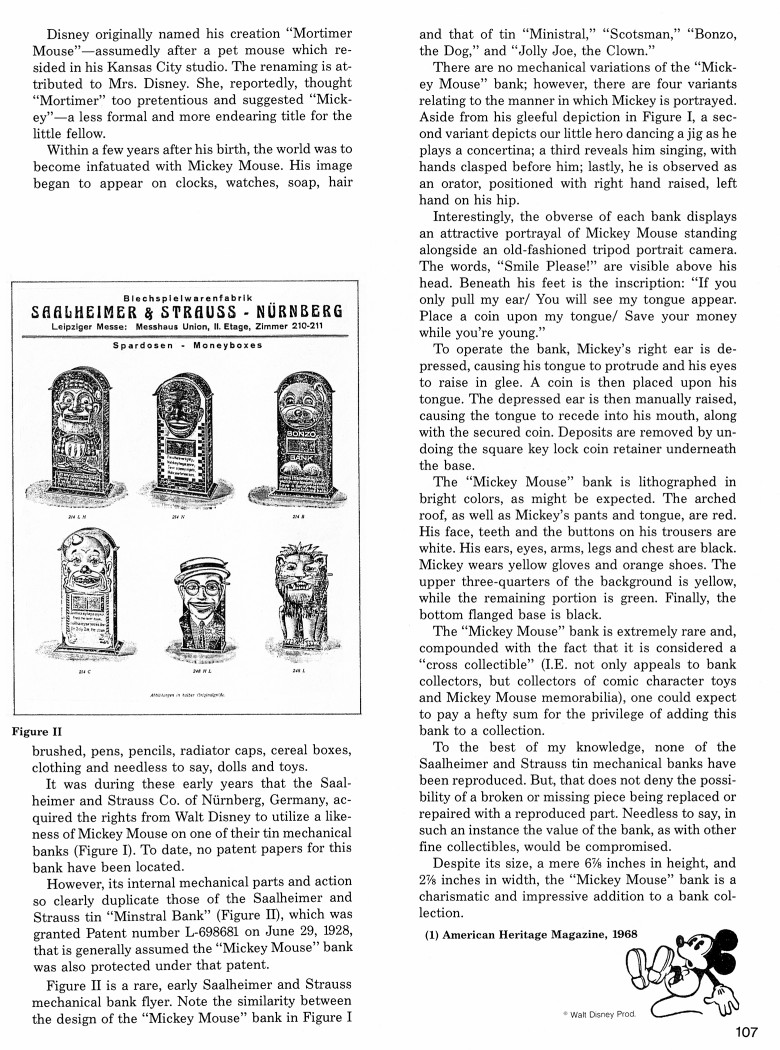|
The Mickey Mouse Tin Bank
by Sy Schreckinger – ANTIQUE TOY WORLD Magazine – August, 1991
The legendary tale of Mickey began with his
conception in 1927 aboard a train bound for California. His creator,
Walter Elias Disney, had come from New York and a most discouraging
meeting with the distributor of his Oswald and Alice series. As per
Walt's recollections: "Was I downhearted? Not a bit! I was happy, at
heart. For, out of the trouble and confusion stood a mocking, merry little
figure. Vague and indefinite at first, but it grew and grew. And finally
arrived — a mouse... By the time my train had reached the Middle West, I had
dressed my dream mouse in a pair of red velvet pants with two huge pearl
buttons." (1) Immediately upon his return to New York, Disney set his
small studio to work on a cartoon that had "the mouse" as its star.
Disney originally named his creation "Mortimer Mouse" — assumedly after
a pet mouse which resided in his Kansas City studio. The renaming is
attributed to Mrs. Disney. She, reportedly, thought "Mortimer" too
pretentious and suggested "Mickey" — a less formal and more endearing title
for the little fellow.
Within a few years after his birth, the world was to become
infatuated with Mickey Mouse. His image began to appear on clocks,
watches, soap, hair brushed, pens, pencils, radiator caps, cereal boxes,
clothing and needless to say, dolls and toys.
It was during these early years that the Saalheimer and Strauss Co.
of Nurnberg, Germany, acquired the rights from Walt Disney to utilize a
likeness of Mickey Mouse on one of their tin mechanical banks (Figure 1).
To date, no patent papers for this bank have been located.
However, its internal mechanical parts and action so clearly
duplicate those of the Saalheimer and Strauss tin "Minstral Bank" (Figure
II), which was granted Patent number L-698681 on June 29, 1928, that is
generally assumed the "Mickey Mouse" bank was also protected under that
patent.
Figure II is a rare, early Saalheimer and Strauss mechanical bank
flyer. Note the similarity between the design of the "Mickey Mouse" bank
in Figure I and that of tin "Ministral," "Scotsman," "Bonzo, the Dog," and
"Jolly Joe, the Clown."
There are no mechanical variations of the "Mickey Mouse" bank;
however, there are four variants relating to the manner in which Mickey is
portrayed. Aside from his gleeful depiction in Figure I, a second variant
depicts our little hero dancing a jig as he plays a concertina; a third
reveals him singing, with hands clasped before him; lastly, he is observed
as an orator, positioned with right hand raised, left hand on his hip.
Interestingly, the obverse of each bank displays an attractive
portrayal of Mickey Mouse standing alongside an old-fashioned tripod
portrait camera. The words, "Smile Please!" are visible above his head.
Beneath his feet is the inscription: "If you only pull my ear, you will
see my tongue appear. Place a coin upon my tongue/ Save your money while
you're young."
To operate the bank, Mickey's right ear is depressed, causing his
tongue to protrude and his eyes to raise in glee. A coin is then placed
upon his tongue. The depressed ear is then manually raised, causing the
tongue to recede into his mouth, along with the secured coin. Deposits are
removed by undoing the square key lock coin retainer underneath the base.
The "Mickey Mouse" bank is lithographed in bright colors, as might be
expected. The arched roof, as well as Mickey's pants and tongue, are red.
His face, teeth and the buttons on his trousers are white. His ears, eyes,
arms, legs and chest are black. Mickey wears yellow gloves and orange
shoes. The upper three-quarters of the background is yellow, while the
remaining portion is green. Finally, the bottom flanged base is black.
The "Mickey Mouse" bank is extremely rare and, compounded with the
fact that it is considered a "cross collectible" (I.E. not only appeals to
bank collectors, but collectors of comic character toys and Mickey Mouse
memorabilia), one could expect to pay a hefty sum for the privilege of
adding this bank to a collection.
To the best of my knowledge, none of the Saalheimer and Strauss tin
mechanical banks have been reproduced. But, that does not deny the
possibility of a broken or missing piece being replaced or repaired with a
reproduced part. Needless to say, in such an instance the value of the
bank, as with other fine collectibles, would be compromised.
Despite its size, a mere 6-7/8 inches in height, and 2-7/8 inches in
width, the "Mickey Mouse" bank is a charismatic and impressive addition to
a bank collection.
(1) American Heritage Magazine, 1968.
|


